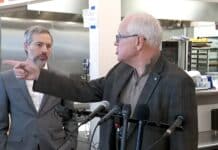
A new safe and sick time law that was heavily debated in the legislature 11 months ago is set to take effect on New Year’s Day.
Starting Jan. 1 all Minnesota workers will earn at least one hour of paid sick and safe time per every 30 hours worked, up to at least 48 hours per year. That’s according to language in the legislation that Gov. Tim Walz signed into law in May.
The commissioner of Labor and Industry can fine employers up to $10,000 if they don’t submit required earned safe and sick time-related wage records upon the commissioner’s request.
The bill, sponsored by Rep. Liz Olson, DFL-Duluth, passed on a party-line vote in the House in February after more than seven hours of floor debate among Republicans and Democrats. But it never made it to the floor in the Senate as a standalone bill, where the DFL held just a one vote advantage. Instead, Democrats included the program in their sweeping omnibus jobs, labor and economic development bill that they passed in both houses on a party-line vote in May.
During the Feb. 16 debate in the House over the standalone bill, Republicans criticized what they called a “one-size-fits-all” mandate for every employer in the state.
“Our job creators are valuable to provide the jobs we all need,” said House Majority Leader Lisa Demuth, R-Cold Spring, during a debate on the legislation. “Those job creators also provide benefits — not mandates — but benefits and that is used as a recruitment tool and a retention tool to draw those job seekers and employees to us. Government mandates for paid leave is bad policy. It is not sustainable, and it is bad policy.”
Rep. Dave Baker, R-Willmar, offered a handful of amendments that would have exempted employers with fewer than 26 employees, withheld the benefit from seasonal workers, and obligated workers to be on the job for at least 90 days before utilizing the benefit. Democrats voted down all those amendments.
Democrats touted the passage in the House as a victory for workers.
“For over 900,000 Minnesota workers they don’t have a single hour of paid time off to care for themselves or loved ones,” said Rep. Olson, the chief author. “They are disproportionately women, BIPOC Minnesotans and low wage workers. These workers are faced with a terrible choice when they get sick: they can go into work, forgoing the time they would be taking care of themselves, or heading to the doctor.”
The new law applies to employers with any number of workers, and it covers all employees, including part-time and temporary. It also defines an employee as anyone who works 80 or more hours during a calendar year. The law does not apply to those deemed independent contractors.
The earned safe and sick time can be used for any of the following reasons:
- the employee’s mental or physical illness, treatment, or preventative care;
- care of a sick family member or a family member in need of preventative care or treatment;
- an absence related to domestic abuse, sexual assault, or stalking of the employee or a family member;
- closure of the employee’s workplace or a family member’s school or care facility due to weather or a public emergency;
- inability to telework due to an employer’s policy or while seeking a medical diagnosis or testing for a communicable disease related to a public emergency at the employer’s request or after the employee’s exposure; and
- a determination by a health care provider that the employee or a family member is at risk of infecting others with a communicable disease.
Hank Long
Hank Long is a journalism and communications professional whose writing career includes coverage of the Minnesota legislature, city and county governments and the commercial real estate industry. Hank received his undergraduate degree at the University of Minnesota, where he studied journalism, and his law degree at the University of St. Thomas. The Minnesota native lives in the Twin Cities with his wife and four children. His dream is to be around when the Vikings win the Super Bowl.










